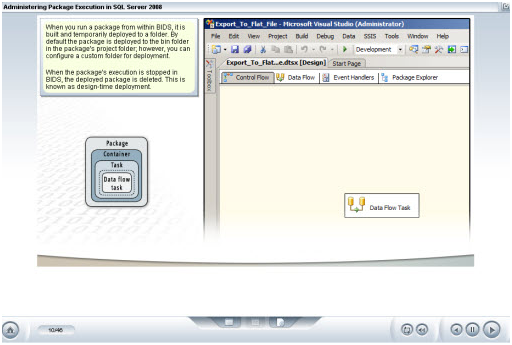SQL Server 2008 makes business intelligence (BI) available to everyone through deep integration with Microsoft Office 2007 family, providing the right tool, to the right user, at the right price. Employees at all levels of an organization can see and help to influence the performance of the business by working with tools that are both easy to use and powerful. With the Database Engine at its core, SQL 2008 offers integration, reporting, and analysis tools to access and process the data necessary to create business solutions. This course gives an overview of the importance of business intelligence in today's competitive market and introduces the capabilities provided by the Server's Integration Services, Reporting Services, and Analysis Services. It then focuses on the use of SQL Integration Services as a data integration solution and outlines the installation and configuration of this server component. The course also covers the key utilities used to configure and manage Integration Services, including the Server Management Studio, Business Intelligence Development Studio, configuration wizards, and command-line tools.
This course covers the objectives for the Microsoft exam: 70-448 T'S: Microsoft SQL Server 2008, Business Intelligence Development and Maintenance. Passing this exam will earn the learner Microsoft Certified Technology Specialist (MCTS): SQL Server 2008, Business Intelligence Development and Maintenance certification.
 Our Training Includes Our Training Includes
 Multi Media Interactive Training lessons Multi Media Interactive Training lessons
  Online Labs Online Labs
  Printable transcripts of all lessons for easy review Printable transcripts of all lessons for easy review
  Online Mentoring to Instructors 24 x 7 to answer all questions Online Mentoring to Instructors 24 x 7 to answer all questions
  Test Preps to test your skills Test Preps to test your skills
Training Outline
Implementing SQL Server 2008 Integration Services
- Business Intelligence technologies
- Install Integration Services
- Features of SQL Server 2008 Integration Services
- Tools in the Integration Services studios
- How to create a data package
- Verify and manage a data package
- The SQL Server 2008 Integration Services tools
Configuring Integration Services Packages
- How the connection manager works
- Work with control flows
- Event handlers and Integration Services variables
- Use Property Expressions
- Checkpoints and transactions
- Implement control flow
- Implement data flow
- Create an SSIS solution
- Create an SSIS data package flow
Deploying Integration Services Packages
- Create a package configuration
- Deploy SSIS packages
- Manually execute SSIS packages
- Schedule the execution of your SSIS packages
- Use the SQL Server Import and Export Wizard to create a simple package
- Set up the Deployment Bundle
- Install and run SSIS packages
Managing SSIS Packages
- Ssore information in a log file
- Create a log on a server
- Configure a package to handle bad data
- Perform debugging
- Ways to secure SSIS packages
- Implement logging
- Debug SSIS packages
- Secure an SSIS package
Implementing Reporting Services Solutions
- SQL Reporting Services is used for
- Install Reporting Services
- Configure Reporting Services
- How to author SQL Server reports
- Format reports
- How to filter data
- Add interactivity to reports
- Add expressions
- Add custom code in reports
- Use reports in SQL Server 2008
Deploying and Delivering Reporting Services Reports
- Deploy a report with SQL Server 2008
- How report models are used
- Recognize how to integrate with Report Server Web Service
- How to integrate using URL Access
- Use ReportViewer controls
- Create a schedule
- Set up subscriptions
- Report caching
- Create a report snapshot
- Create report models
- Create schedules and set up report caching
Maintaining Reporting Services
- Configure SSRS
- Perform administration and maintenance of SSRS
- Features of SSRS Security
- Create a new role
- Automate SSRS administration
- Manage reporting services
- Monitor and maintain SSRS performance
Implementing Analysis Services Solutions
- Features of SQL Server 2008 Analysis Services
Install Analysis Services
Implement multidimensional data
Implement a data source
How to use data source views
Create an SSAS cube
Define dimensions, hierarchies, and attributes
Recognize how to use measures
Calculations
Create a data source and data source view
Implement a SQL Server Analysis Services cube
Querying Cubes and Working with Data Mining in SSAS
- Query cubes using MDX
Work with KPIs
Create actions with SSAS
How data mining works
Create a data mining solution
Query a data mining solution
Use drillthrough on a data mining solution
Cubes in SQL Server 2008
Managing Analysis Services Solutions
- Methods for deploying a SQL Server Analysis Services project
- Implement security
- Disaster recovery solutions for SSAS
- Back up and restore an SSAS database
- Detach and attach an SSAS database
- Manage SQL Server 2008 Analysis Services
- Monitor an SSAS instance
- Administer SQL Server 2008 Analysis Services
|












